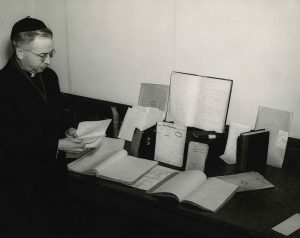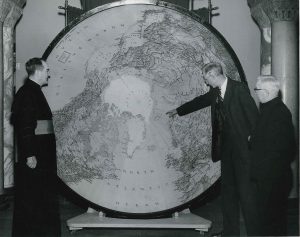
“When Father Dutilly returned from the Arctic last year, he brought a polar bear skin with him, which, I understand, was to have gone to you.”
-John Murphy to Rev. Joseph M. Corrigan, Catholic University Rector, 1940
In 1940, an office on the fourth floor of McMahon – room 405 to be specific – became known as the “Igloo” in official University correspondence. It is in this space that the Arctic Institute of the Catholic University of America operated. Fittingly this site was a hive of activity in the winter months, with scholars cataloging botanical, geological, and anthropological specimens collected from the Arctic Circle. But come the summertime, its faculty would disperse to the North, hitching rides on canoes, seaplanes, and icebreaker ships in search of new Arctic plant life and soil samples.
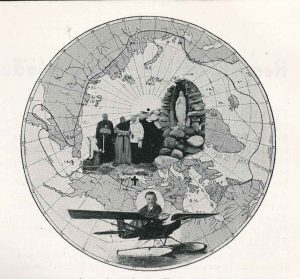
Beginning in 1895, Catholic University became a center for botanical research. In that year, the Langlois Herbarium was donated to the University by the estate of August Barthelemy Langlois. This collection consisted of over 20,00 specimens. This massive collection served as foundation for the Herbarium, with additional deposits occurring through the 1930s. One such scholar who donated to the collection was Danish Arctic explorer and botanist, Herman Theodor Holm. One of the earliest laypeople to earn a doctorate at Catholic, Holm would teach briefly at the University and donate some of his own library to the campus upon his death in 1932. Based on the strength of its collections, Fr. Artheme Dutilly (1896-1973) would join Catholic University in 1937 as a research associate in the Department of Biology.
Born in Quebec in 1896, Fr. Dutilly (1896-1973) was an Oblate Missionary priest and celebrated botanist with a particular interest in Arctic flora. In 1933, at the behest of Pope Pius XI, he was appointed Naturalist of the Oblate Arctic Missionaries. Dutilly would spend his summers traveling within the Arctic Circle, collecting soil, plant, and anthropological specimens to be prepared and sent to the Lateran Museums in Rome. He accompanied Oblate missionaries working in the Arctic, hitching rides on their motor ship M. F. Therese and, later, their seaplane, the Santa Maria. In both cases, Dutilly was not merely a collector of samples. He was also a radio operator, plane mechanic, and fighter of bears.
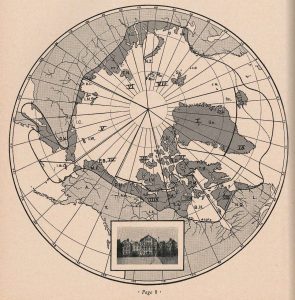
In one harrowing event, a polar bear overtook Dutilly’s boat with the priest fending it off. He also served as the mechanic during many of his flights, from soldering broken pieces to spending two days in the wilderness rigging a failing engine to continue on with his fieldwork. (Despite working, the plane still needed to stop every two hours to replenish its leaking oil supply!)
Even after relocating to Washington, Dutilly did not change his fieldwork operations and instead brought along several other Catholic University faculty and students with him. Scholars such as Fr. Hugh T. O’Neill and Fr. Maximillian Duman, OSB, were also prominent figures in the history of the Arctic Institute and accomplished researchers. During the summer, they would be off to various points in the Arctic. (It was reported that in 1941 Dutilly traveled over 15,000 miles across the Canadian Arctic!) And in the winter, he would return to Washington to inventory the materials for shipment to the Lateran Museums, as well as keeping some in DC at the Smithsonian and Catholic University.
With the formal founding of the Arctic Institute in 1940, the “Igloo” contained more than 50,000 mounted Arctic plants, over 900 volumes on Arctic vegetation, and numerous samples of soil, fossils, rocks, and minerals. Dutilly even worked with the Inuit populations to collect philological texts on indigenous languages. It was the single largest collection of Arctic material in the Americas…well outside the Arctic that is!
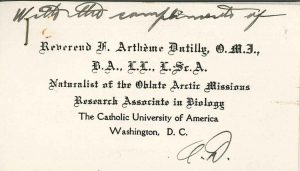
In 1947, the Department of Defense began to provide additional funding for Dutilly’s research, with an added emphasis on Alaska and Greenland. The expressed purpose of this research grant was to explore ways to study the soil and plant life of the Arctic to better understand how to develop agriculture in this otherwise inhospitable zone.
Dutilly remained a faculty member of the Biology and Geography departments until 1967. He served as the Director of the Arctic Institute (1939), Curator of the Department of Biology Herbarium (1947), and as a Lecturer in the Department of Geography (1947). Not long after his departure, the Arctic Institute melted away. The collections of the Institute and Herbarium were donated to other institutions in 1985-1986.
While we have yet to find the “polar bear skin” Dutilly allegedly sent to the University’s rector, the Archives does maintain examples of Dutilly’s anthropological materials, as well as the papers of Herman Theodor Holm: https://findingaids.lib.catholic.edu/repositories/2/resources/176
